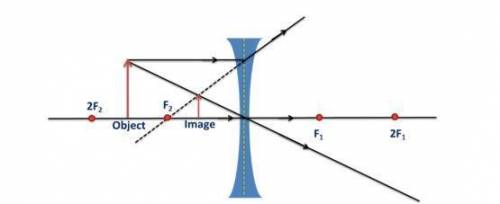
Physics, 21.06.2019 17:50 Riplilpeep
Which describes an image that can be produced by a concave lens? the image is real and smaller than the object. the image is virtual and larger than the object. the image is virtual and smaller than the object. the image is real and larger than the object.

Answers: 3


Other questions on the subject: Physics

Physics, 22.06.2019 05:50, gabigraceberg
High schoolphysics 5+3 pts a neon light consists of a glass tube with metal wires at each end. when connected to a high-voltage source, the gas glows. if a fly lands on the glass tube, what will most likely happen? a) the fly will not feel a shock because the glass conducts any free electrons back into the gas. b) electrons will flow directly from the metal wires along the glass and shock the fly. c) the fly will not feel a shock because the glass insulates it from the electrons in the gas and the metal. d) electrons that are moving through the gas will be conducted through the glass and shock the fly.
Answers: 3

Physics, 22.06.2019 09:30, officialariana01
In a heat engine if 1000 j of heat enters the system the piston does 500 j of work, what is the final internal energy of the system if the initial energy was 2000 j? 1. write the equation 2.list out your known variables 3.plug the numbers into the equations 4.solve 5.write your solution statement that includes initial energy and final
Answers: 3

Physics, 22.06.2019 17:00, griffinkiley22
Two manned satellites approaching one another at a relative speed of 0.550 m/s intend to dock. the first has a mass of 2.50 ✕ 103 kg, and the second a mass of 7.50 ✕ 103 kg. assume that the positive direction is directed from the second satellite towards the first satellite. (a) calculate the final velocity after docking, in the frame of reference in which the first satellite was originally at rest.(b) what is the loss of kinetic energy in this inelastic collision? (c) repeat both parts, in the frame of reference in which the second satellite was originally at rest. final velocity(d) loss of kinetic energy = ?
Answers: 2

Physics, 22.06.2019 18:30, Felici8617
4. now look at the green lines you created by connecting the three boiling point data points and the three melting point data points. for each of these lines, describe any trends you see. 5. locate the elements on your periodic table that you circled in green on your graph. what term or description would you use to identify these elements with respect to the periodic table? 7. using the room temperature line (orange line) and your periodic table, make lists that identify the state of matter (gas, liquid, or solid) in which each element you plotted exists at room temperature. explain your answers.
Answers: 2
You know the right answer?
Which describes an image that can be produced by a concave lens? the image is real and smaller than...
Questions in other subjects:


Mathematics, 16.12.2020 20:00

Mathematics, 16.12.2020 20:00


Biology, 16.12.2020 20:00

English, 16.12.2020 20:00


History, 16.12.2020 20:00

Mathematics, 16.12.2020 20:00

Mathematics, 16.12.2020 20:00




